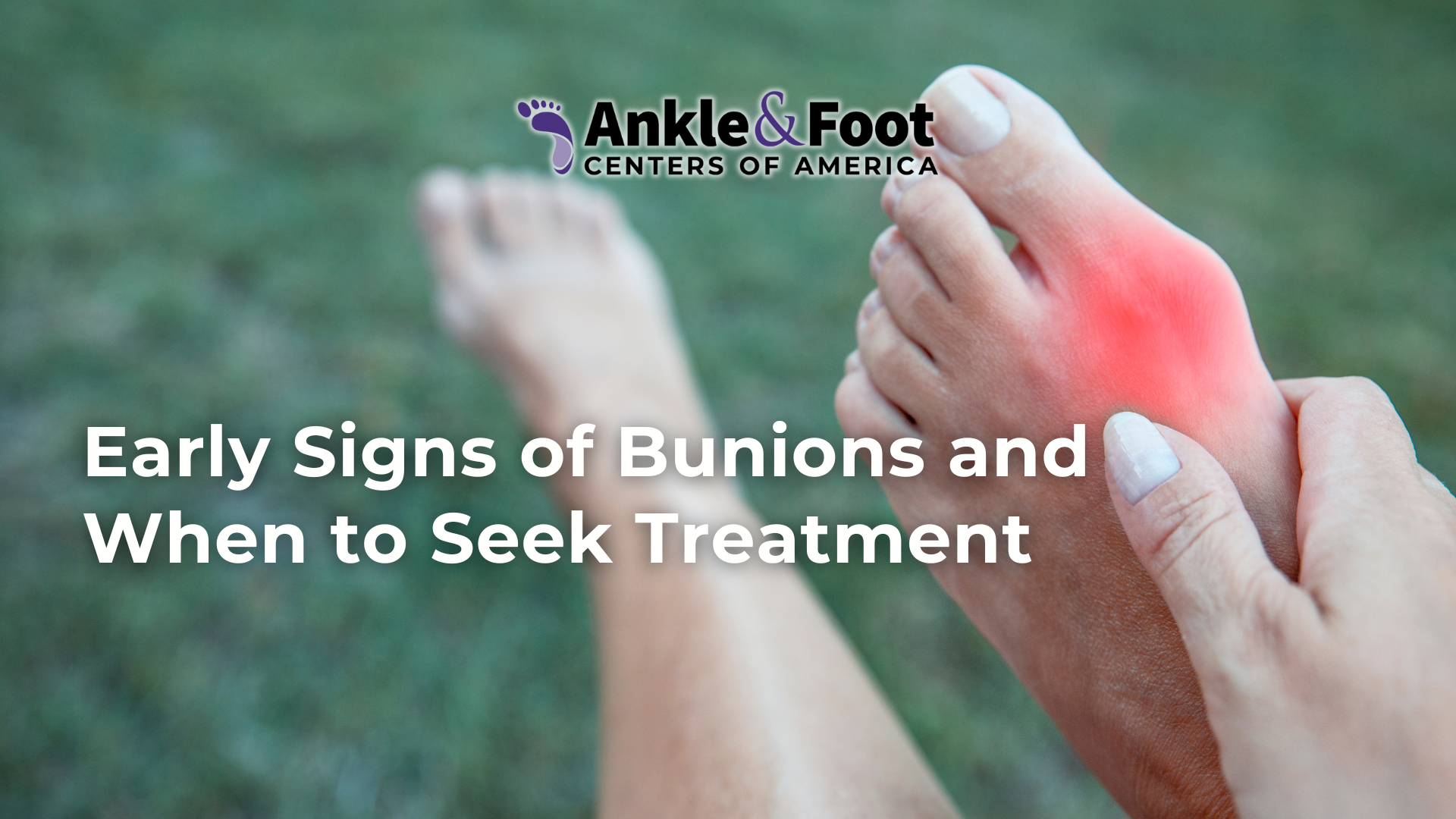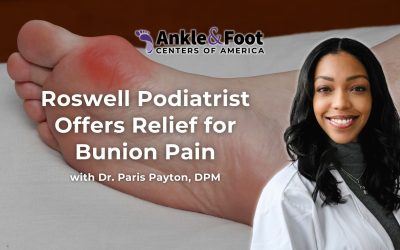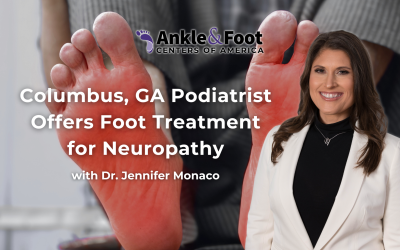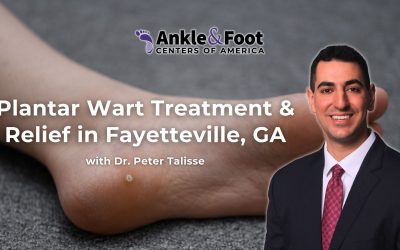If you’ve noticed a bump forming near your big toe or your shoes suddenly feel tight, you may be seeing the early signs of a bunion. These common foot deformities tend to develop slowly—causing irritation, swelling, and visible changes in the shape of your foot.
The good news? Recognizing bunion symptoms early can significantly improve your comfort and long-term foot health.
Table of Contents
What Is a Bunion?
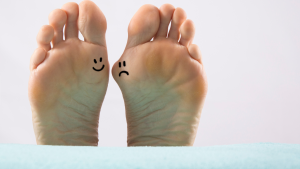 A bunion is a bony bump that forms at the base of your big toe. It occurs when the joint shifts out of place, causing the big toe to lean toward the second toe. As this misalignment progresses, the joint pushes outward—creating the characteristic bump.
A bunion is a bony bump that forms at the base of your big toe. It occurs when the joint shifts out of place, causing the big toe to lean toward the second toe. As this misalignment progresses, the joint pushes outward—creating the characteristic bump.
Bunions can cause pain, swelling, and redness, especially when wearing tight or narrow shoes.
What does a bunion look like on your foot? You may notice:
-
A visible bump near the big toe
-
The big toe pushing against the second toe
-
A widening of the forefoot
Although bunions are more common in adults, they can also affect teenagers and children, especially those with inherited foot structures.
Early Signs of Bunions
Bunions don’t form overnight. In the early stages, symptoms can be subtle. But recognizing them early may help prevent further progression.
Look out for these early warning signs:
-
A small bump near the base of the big toe
-
Redness, swelling, or tenderness around the joint
-
Pain triggered by tight shoes or standing for long periods
-
A slight inward shift of the big toe
-
Limited movement or stiffness in the joint
Some people also report a burning or aching sensation near the bump, often worsened by narrow footwear. These signs may come and go initially but typically become more persistent over time.
Common Bunion Symptoms
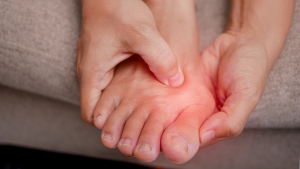 As a bunion progresses, symptoms become more noticeable and can start to interfere with your daily life. Not only can the discomfort make it hard to walk, but it may also affect your ability to wear your usual shoes.
As a bunion progresses, symptoms become more noticeable and can start to interfere with your daily life. Not only can the discomfort make it hard to walk, but it may also affect your ability to wear your usual shoes.
Here are the most common bunion symptoms to watch for:
1. Persistent Pain
Many people describe bunion pain as a dull ache or a throbbing sensation near the base of the big toe. In many cases, this pain worsens after standing or walking for long periods. Additionally, it may feel sharp or burning—especially when the bunion rubs against tight shoes.
2. Swelling and Redness
The skin around the bunion often becomes irritated. As a result, you may notice swelling, tenderness, or redness in the area. Over time, the joint may feel warm to the touch due to inflammation.
3. Visible Toe Deformity
As the condition worsens, the big toe may lean more toward the second toe. This gradual shift can create a noticeable bump on the side of your foot. Eventually, the pressure may cause the second toe to overlap or shift out of place.
4. Limited Range of Motion
Bunions can also affect how well your big toe moves. You might feel stiffness or tightness, especially when you try to bend or stretch the toe. Because of this, walking or exercising may become uncomfortable.
5. Corns and Calluses
Friction between toes is another common issue. As your big toe pushes against the others, it can cause corns or calluses to develop—usually between the toes or along the side of the bunion. These areas may become rough, thickened, or painful.
6. Difficulty Wearing Shoes
One of the earliest red flags is discomfort in your usual footwear. As the bunion grows, narrow shoes may cause more irritation. For that reason, many people switch to wider shoes, although this may only provide temporary relief.
Bunion Relief and Self-Care Tips
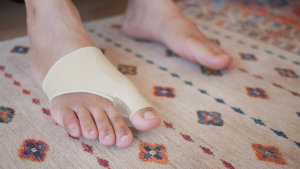 While bunions won’t go away on their own, early care can ease discomfort and slow progression. Here are a few effective ways to find bunion relief at home:
While bunions won’t go away on their own, early care can ease discomfort and slow progression. Here are a few effective ways to find bunion relief at home:
-
Wear supportive shoes with a wide toe box to reduce pressure.
-
Use bunion pads or cushions to prevent rubbing and irritation.
-
Apply ice to reduce swelling and relieve pain after long periods of standing.
-
Take over-the-counter pain relievers as needed for inflammation.
-
Try gentle toe stretches to improve joint flexibility.
While these options provide relief, they don’t correct the deformity. If symptoms persist, it’s best to consult a podiatrist for treatment options tailored to your needs.
FAQ: Bunions
Q: What causes bunions?
Bunions often result from inherited foot structure. Poor footwear choices—like tight or narrow shoes—can make them worse.
Q: Do bunions go away on their own?
No. While symptoms may improve temporarily with self-care, the bunion itself typically requires medical treatment.
Q: Do bunion pads work?
Yes. Bunion pads can relieve pain and prevent friction, especially inside shoes, but they don’t cure the deformity.
Q: Do bunion correctors work?
Bunion correctors, like toe spacers or splints, may help relieve pressure and improve toe alignment temporarily. While they don’t reverse the deformity, they can provide short-term relief—especially when paired with supportive footwear.
Q: When is surgery needed?
Bunion surgery may be necessary when pain is constant, deformity progresses, or conservative treatments no longer work.

Don’t Wait for Bunion Pain to Get Worse
Bunions can start small—but they rarely stay that way. Acting early helps protect your foot health and prevent more serious complications.
If you’re struggling with bunion symptoms, the podiatrists at Ankle & Foot Centers of America can help. From custom shoe advice to advanced surgical solutions, our experienced team offers personalized bunion treatment to help you walk comfortably again.
Schedule an appointment today and take the first step toward bunion relief.

